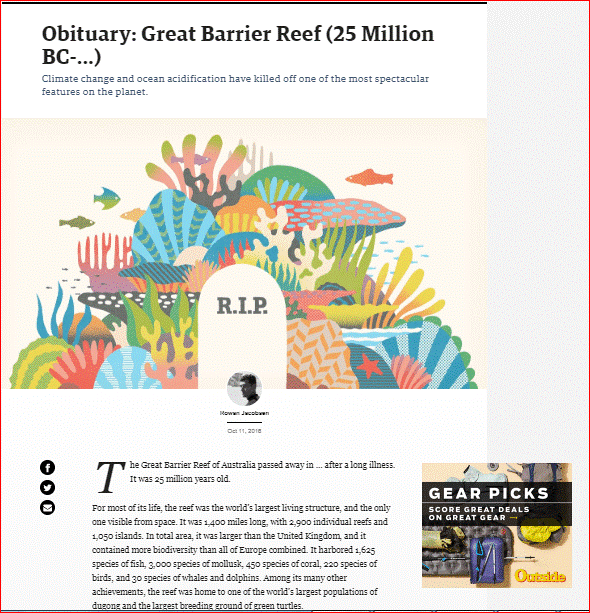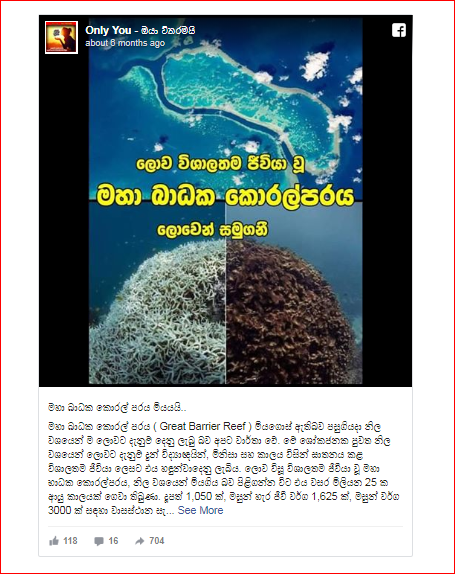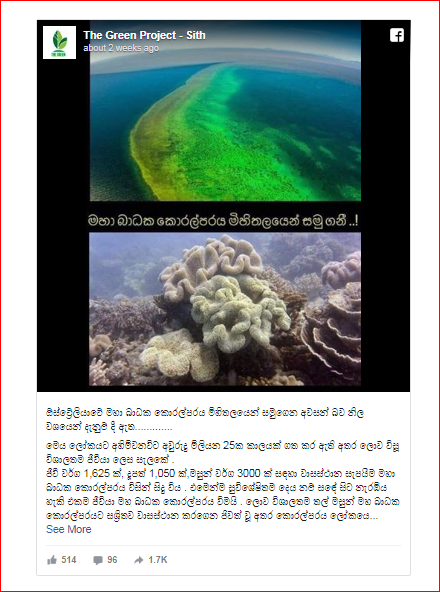Physical Address
23,24,25 & 26, 2nd Floor, Software Technology Park India, Opp: Garware Stadium,MIDC, Chikalthana, Aurangabad, Maharashtra – 431001 India
Physical Address
23,24,25 & 26, 2nd Floor, Software Technology Park India, Opp: Garware Stadium,MIDC, Chikalthana, Aurangabad, Maharashtra – 431001 India

We have noticed a lot of rumors related to global climate change and the death of the Great Barrier Reef in Australia. While there has been considerable damage to the reef, esepcially over a number of serious bleaching incidents during the decade, conservation programs are in place to restore this world’s largest coral reef.
Main Claim: The world’s largest coral reef system, Australia’s Great Barrier Reef, has died. It is the largest creature killed by man and time.
Claim Description: The death of Australia’s Great Barrier Reef was shared in the form of an obituary which stated that the world’s largest living structure was officially declared dead after 25 million years.
And with that it is said the Great Barrier Reef contained more biodiversity than the whole of Europe combined and with its dead large numbers of fish and other life forms had lost their habitat as seen below.

The main reasons which had contributed to the death of the Great Barrier Reef have been listed as global temperature rise due to human activities, the addition of micro plastic particles to the sea, as well as factory waste.
And these posts were viral in Sinhala language in Sri Lanka as well as seen below.


Great Barrier Reef
The Great Barrier Reef stretches more than 2300 kilometers along Queensland’s coastline and is made up of around 3000 individual coral reefs.
The Reef is of special significance to Aboriginal and Torres Strait people, who continue to live in harmony with the Great Barrier Reef and also consider it to be a place of cultural significance.
The Great Barrier Reef is home for around 1625 types of fish, 600 types of coral, 100 species of jellyfish, 3000 varieties of mollusks, more than 30 species of other marine mammals such as whales, dugong and dolphins, along with 133 varieties of sharks and rays and much more. More such information can be searched from here Archived.
To find out about the extent of the damage that has happened to the Great Barrier Reef, who confirmed that “The Great Barrier Reef Marine Park is bigger in size than Italy and is made up of about 3000 individual reefs – it’s not dead”
Threats to the Great Barrier Reef
The two biggest perceived threats to the Great Barrier Reef Marine Park at present are coral bleaching and the crown-of-thorns starfish. Both have major effects on the reef, and must be prevented as the future of the Reef depends on it.
Coral bleaching
Coral bleaching is one of the biggest ongoing threats to the Great Barrier Reef marine park. This is an issue that can affect all reefs, anywhere in the world, as it is caused when the relationship between coral and symbiotic algae is disrupted. When coral becomes stressed due to heat and other changes in the environment, it may expel its algae, which in turn, causes the coral to have a bleached, whiter look. The algae gives the coral not only its color but also its nutrients, as the zooxanthellae in the algae go through photosynthesis to feed the organism.
About two-thirds of the coral in the reef off the coast of Australia has been affected by bleaching caused by unusually high ocean temperatures in 2016, 2017 and 2020. However, there is renewed hope as the Great Barrier Reef is erupting with color again as the natural wonder recovers from these life-threatening coral bleaching.
The Australian Institute of Marine Science (AIMS) announced that new coral had populated the northern and central parts of the damaged Great Barrier Reef, according to the AIMS 2021 annual report.
Crown-of-thorns starfish
The crown-of-thorns starfish is a current plight to many individual reefs in the Great Barrier Reef Marine Park. The invasive species, while damaging, is native to the Great Barrier Reef Marine Park and is always found all over the reef. However, in recent years, there has been a rise in its numbers due to unknown reasons. The crown-of-thorns feeds on corals, attacking particularly the staghorn, which is a fast-growing coral. They consume large quantities, leaving a trail of bleaching coral skeletons behind as they eat their prey. More can be read from here Archived.
Impacts of Climate Change on Great Barrier Reef
The survival of the Great Barrier Reef is also severely threatened by climate change caused by rising global emissions. Underwater heatwaves, caused by rising global emissions, resulting from burning of fossil fuels, are generating severe coral bleaching and mortality.
The UNESCO World Heritage Committee considers the state of conservation of world heritage properties. In July 2021, the committee met and noted with concern that the long-term outlook for the Reef had deteriorated, with climate change being the most serious threat.
The committee agreed that actions to build the resilience of the Reef and address other factors (including climate change and improve water quality) were of utmost importance. The committee requested that Australia invite UNESCO and the International Union for Conservation of Nature (IUCN) to conduct a reactive monitoring mission and submit an updated State of Conservation Report in 2022 for consideration at the next meeting. More can be read from here Archived.
Reef 2050 Long-Term Sustainability Plan
The Reef 2050 Long-Term Sustainability Plan (Reef 2050 Plan) is the overarching Australian and Queensland government action plan to work with partners to protect and manage the Great Barrier Reef.
The Queensland Government has already delivered a number of significant commitments under the Reef 2050 Plan including reducing the impacts of port development through the Sustainable Ports Development Act 2015, introducing net-free fishing zones, launching the Queensland Sustainable Fisheries Strategy, strengthening Reef protection regulations to improve Reef water quality and reducing the impact of vegetation clearing.
While climate change is the single, biggest threat to the Reef, there are a number of other pressures that need to be addressed to reduce the cumulative impacts on the Reef. More details about it can be read from here Archived.